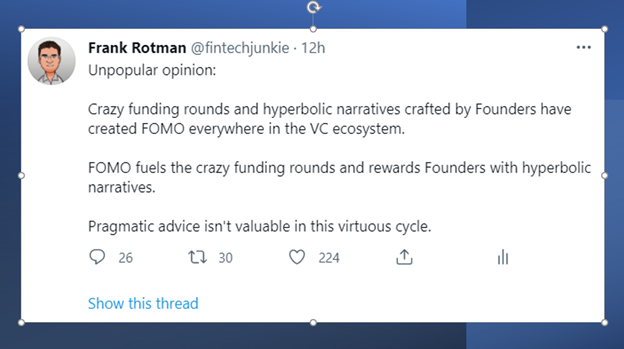
Yesterday I tweeted an unpopular opinion that deserves unpacking.
Valuations are up. Unicorns are getting birthed faster than ever before. Multiples have hit all-time peaks. New investors are aggressively entering the VC ecosystem.
Who’s to blame? What does it mean? Unpacked:
Valuations are up. Unicorns are getting birthed faster than ever before. Multiples have hit all-time peaks. New investors are aggressively entering the VC ecosystem.
Who’s to blame? What does it mean? Unpacked:

2/30: VC is an asset class. Many people don’t think of it that way but it is. And it isn’t a big asset class. It’s small relative to other major asset classes like publicly traded stocks, bonds, currency or real estate. But the VC asset class is growing quickly and accelerating. 

3/30: One driving factor is that alpha has mostly disappeared from the stock market. The vast majority of return can be attributed to a few stocks each year and only 1 in 25 stocks are investments worthy holding over the long-term (relative to Treasuries).
4/30: The number of listed companies has also been on a steady decline with big companies becoming bigger and smaller companies disappearing through mergers and failures. At peak, there were over 7,000 listed companies on the US exchanges and the number today is less than 4,000.
5/30: Another factor is that companies are staying private longer than ever before which means that the highest growth companies are generating significant incremental returns in the private markets. The area under the returns curve is rapidly growing!
6/30: Many VC backed startups of the past decade have grown into great companies and the IPO market has finally re-opened. This combination is generating cash that is flowing back to LPs at an unprecedented pace which then goes right back into the ecosystem. 

7/30: And a massively misunderstood benefit to private investing is that private securities can be structured while public securities can’t. Not all private securities are structured, but the ones that are can lop off the left hand tail of returns.
8/30: So, with all these forces at work it’s not a surprise that money has been pouring into late-stage private markets companies. The asset class is finally big enough to matter (and getting bigger) and the alternatives are getting worse.
9/30: But if the return expectations from these investors is merely “beating the next best alternative” and the next best alternative is investing in the public markets, then these investors should be willing to pay more than historical norms for access to late stage companies.
10/30: This is having a ripple effect on the entire ecosystem because if later stage and public investors are willing to pay more it generates greater paper returns (and secondary liquidity returns) for earlier stage investors if nothing else changes.
11/30: But finding great early stage companies is highly competitive which means that when an early stage VC finds one they can justify “paying up to win” based on the increasing prices paid by later stage investors + the extra returns generated by staying private longer.
12/30: As an early stage investor, these changes in the overall ecosystem are exciting and terrifying. More expensive to play. More return to generate. It puts a premium on “getting it right”. But “getting it right has changed” given the public market’s appetite for growth!
13/30: Because public investors are in “risk on” mode, they’re allowing private investors to sell them half-baked businesses. It doesn’t matter if the third bet in an early investor’s Trifecta thesis loses. They’ve already sold their card for a premium after two winning bets.
14/30: One obvious solution to the above is for VCs to do more work and look deeper to find overlooked ideas and Founders to fund. This is 100% if not 1000% true. But re-training well known patterns of success takes experimentation and the feedback cycle in Venture is long.
15/30: My two cents is that VCs who figure out how to find alpha in early stage overlooked startups are going to crush it over the next decade. They’ll put money to work in companies with fantastic return profiles without being caught up in today’s early stage madness.
16/30: But VCs aren’t the only guilty party. Founders are fueling FOMO. Big outcomes in the public markets are driven by big ideas and Founders have reacted to this by putting plans forward that that describe massive outcomes happening at crazy speeds.
17/30: But isn’t the job of a Founder to be ambitious? To this I say “absolutely yes”. But startups are built in stages and there are big ripple effects to taking on too much money too quickly. Ambition is great, but one can’t forget that a business still needs to be built.
18/30: The Problem: Building a startup is a complex, multi-round game
The goal is to win the game, not to optimize a single move. Founders need to de-risk the drivers of their business, attract talent and capital, and scale their businesses to self-sufficiency. This isn’t easy!
The goal is to win the game, not to optimize a single move. Founders need to de-risk the drivers of their business, attract talent and capital, and scale their businesses to self-sufficiency. This isn’t easy!
19/30: De-risking Drivers
When a startup puts money to work it gains insight into the business’s underlying assumptions.
Positive results: Progress has been made towards de-risking the outcome.
Negative results: At best the business is no closer to de-risking the outcome.
When a startup puts money to work it gains insight into the business’s underlying assumptions.
Positive results: Progress has been made towards de-risking the outcome.
Negative results: At best the business is no closer to de-risking the outcome.
20/30: A business will be attractive to downstream Investors if it’s growing quickly while proving out critical business drivers. Every Startup’s “everything goes right scenario” can pass this test but how often does everything go right?
21/30: Result
A “fully” or “overvalued” startup that isn’t able to significantly de-risk the business in-between capital raises will struggle to attract new investors. Most investors would rather pass than fund a down or flat round. Never forget that Cash = Life.
A “fully” or “overvalued” startup that isn’t able to significantly de-risk the business in-between capital raises will struggle to attract new investors. Most investors would rather pass than fund a down or flat round. Never forget that Cash = Life.
22/30: Attracting and retaining talent
Talent is one of the most critical components in building a startup. Without talent nothing gets done. A super high valuation feels great to existing employees, but this same headline can be a deterrent to new talent.
Talent is one of the most critical components in building a startup. Without talent nothing gets done. A super high valuation feels great to existing employees, but this same headline can be a deterrent to new talent.
23/30: Investors and existing employees might be fine if it takes 1-2 years for a startup to grow into its valuation, but why would a new employee sign-up for this? New employees bear the cost high valuations and a startup needs to hire these employees to deliver its promises!
24/30: “Just let it correct” isn’t as easy as it sounds. Have you ever suffered through a down round? Have you seen what happens when employees have underwater options? Do you understand what it takes to claw out from under a preference stack? This is the definition of pain.
25/30: Result
A “fully” or “overvalued” startup is re-risking the business because navigating the needs of existing and new employees can be challenging. The valuation is the champagne and everything that follows is the hangover.
A “fully” or “overvalued” startup is re-risking the business because navigating the needs of existing and new employees can be challenging. The valuation is the champagne and everything that follows is the hangover.
26/30: Scaling to self-sufficiency
The public markets have historically wanted self-sufficient companies. But investors are in “risk on” mode and therefore have embraced high-growth, money-losing businesses. But optimizing for this is risky because market appetites change!
The public markets have historically wanted self-sufficient companies. But investors are in “risk on” mode and therefore have embraced high-growth, money-losing businesses. But optimizing for this is risky because market appetites change!
27/30: Optimizing for today’s market conditions means proving you can build a durable and profitable business isn’t necessary. The sprint for the exit door means optimizing for growth even if it isn’t good growth and if the dance stops the business could fall apart.
28/30: Result
A “fully” or “overvalued” startup takes on additional risk if it tries to grow into its valuation as quickly as possible. Building a durable business takes time and startups that grow like weeds might actually turn out to be weeds.
A “fully” or “overvalued” startup takes on additional risk if it tries to grow into its valuation as quickly as possible. Building a durable business takes time and startups that grow like weeds might actually turn out to be weeds.
29/30: The “so what” is that the VC asset class is evolving and as a result not all pieces are in balance. The system is optimized for “today” and it’s unclear how long “today” will last. Any shift in risk appetite will create ripples just like today’s “risk on” phase has.
30/30: As an investor, all I can do is give good, pragmatic advice to Founders and help them build self-sufficient, scaled business that have value in all markets. And when a company I’ve invested in decides to take on new capital I can help guide them to a balanced outcome.
• • •
Missing some Tweet in this thread? You can try to
force a refresh









